4 Saturday Morning Cartoons That Sparked Bizarre Conspiracy Theories

For decades, Saturday morning cartoons have entertained children with goofy programs about wacky characters (and laboriously sanitized adaptations of gore-soaked R-rated action movies). But as anyone who’s ever spent more than four seconds on the internet can tell you, human beings are prone to conspiratorial thinking. Saturday morning cartoons are no exception. Yes, some folks have some pretty outlandish theories about these TV shows that, in retrospect, really only existed to trick children into desiring cheap plastic toys and sugary cereals, such as how…
Click right here to get the best of Cracked sent to your inbox.
‘Tiny Toon Adventures’ Was Canceled Because of a Stalker
Rather than following Buster and Babs Bunny into middle age as they struggle to pay off the crippling student loan debt they accrued at Acme Looniversity, Tiny Toon Adventures wrapped up after just three seasons, arguably at the show’s height of popularity.
Don't Miss
Why such an abrupt and sudden ending? A number of fans believe that it was because an internet stalker became obsessed with one of the voice actors, with their behavior being so “out of line” that Warner Bros. canceled the show altogether. This would also explain why the final episode featured an insulting caricature of the actual stalker.
But this isn’t exactly true. YouTuber Bernievidz dug into this theory and found that much of the so-called “evidence” behind it can be traced back to “unsubstantiated rumors” published on a “forum for furries.”
While some fans may have been sending creepy letters to the Tiny Toon staff, seemingly prompting additional security measures, the issue didn’t influence the show’s end date. Production on Tiny Toon Adventures was stopped to make room for other Warner Bros. animation projects, including Animaniacs, Freakazoid and Batman: The Animated Series. As the show’s creator, Tom Ruegger, later admitted, “It was time to do other things.”
Mighty Mouse Did Cocaine One Time
A 1987 episode of Mighty Mouse: The New Adventures found the titular rodent hero conspicuously sniffing a powdery substance to boost his spirits — after all, it was the 1980s. Furthermore, the reboot was developed by Ralph Bakshi, the notoriously subversive animator behind movies like Wizards and Fritz the Cat. It took the better part of a year, but eventually, there was a highly-publicized backlash to the scene, with an outspoken conservative watch group decrying that Mighty Mouse was showing kids that “cocaine helps one overcome feeling ‘down.’”
As a result of the controversy, the network cut the scene out of the episode’s master tape. The drastic move seemingly signaled that the scene really was meant to reference drug use, with rumors circulating for decades that Bakshi had inserted “sneaky images of Mighty Mouse snorting coke” into a kid’s cartoon.
But this wasn’t the case, as Bakshi tried to make clear back in 1988. The powder in question wasn’t cocaine, but rather, a crushed flower that serves to remind Mighty Mouse of an impoverished flower girl he encountered. Bakshi claimed that the scene in no way resembled drug use and was never intended to: “He sniffs the petals right out of the palm of his hand. There was no rolled-up 20-dollar bill or anything. No wink at the audience. Nothing like that.”
‘The Smurfs’ Was Secretly Cold War Propaganda
Everyone who doesn’t stop to really consider the horrifying biological implications of their society loves The Smurfs, those tiny blue creatures who live in a toadstool village situated somewhere inside of a deadly war zone. While you may not think that the Smurfs serve any deeper allegorical function, some fans have other ideas…
A long-percolating theory suggests that the Smurfs, the product of Belgian artist Peyo, were actually created to promote Communism to children during the Cold War. After all, the Smurfs live in a carefree socialist utopia, with a leader who wears red and “bears a passing resemblance to Karl Marx.” The villainous, greedy Gargamel, of course, represents capitalism. And even the name “Smurf” could be an acronym standing for “Small Men Under Red Forces.”
That being said, according to Peyo’s family, he had no interest in politics. And if the Smurfs really are anti-capitalist crusaders, explain the staggering amount of Smurf merchandise — not to mention the time they happily smurfed for Big Oil.
A Whole Lot of Cartoons Predicted 9/11, Apparently
A lot of pop culture has retroactively been singled out for supposedly predicting the events of 9/11. From the Super Mario Bros. movie to The Muppets to the X-Files spin-off The Lone Gunmen, itself a show centered on oddball conspiracy theorists, presumably because the universe is mocking us.
Well, a lot of cartoons have also “predicted” 9/11, including an episode of Teenage Mutant Ninja Turtles in which Shredder plots an attack on the World Trade Center — and the Turtles nearly fly their plane into the twin towers while trying to stop him. Cowabunga?
Similarly, an episode of Men in Black: The Series involved a blimp narrowly avoiding a collision with the towers.
Oddest of all, a 1994 episode of Iron Man found The Mandarin and M.O.D.O.K. bombing the World Trade Center and plotting to crash a plane into the Pentagon.
Presumably, magical rings could melt steel beams.
You (yes, you) should follow JM on Twitter (if it still exists by the time you’re reading this).